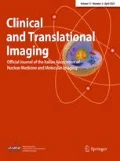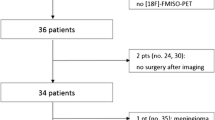Abstract
Purpose
Hypoxic tumors have been demonstrated to be associated with amplified resistance to radiotherapy, chemo-resistance and less favorable outcome after surgery. Non-invasive identification and quantification of hypoxia in humans affected by glioma can be achieved using PET/CT and MRI techniques, although their use is still limited to the research setting. The objective of this review is to present an update of the literature about the potential clinical utility of FMISO PET imaging for the evaluation of hypoxia in patients with glioma, in comparison with advanced MRI techniques, when available.
Methods
A comprehensive search strategy was used based on SCOPUS and PubMed databases using the following terms: “FMISO”/“Fluoromisonidazole” AND “brain tumor”/“glioma” AND “PET”/“Positron Emission Tomography”. From all studies published in English, we selected—for this review—the most relevant articles of the last 20 years, evaluating the use of FMISO PET in glioma patients, and comparing PET findings with MRI imaging (when available).
Results
The use of PET/CT with hypoxia radiotracers in glioma is still limited due to fragmentary data and scarce number of clinical trials in this setting. The most used PET radiotracer for the quantification of hypoxia brain tumor is 18F-FMISO and advanced MRI techniques may provide additional value, especially to couple perfusion information to hypoxia data obtained by PET. As example, relative cerebral blood volume maps could be integrated with PET imaging results for more precise and integrated evaluation of hypoxia, neo-angiogenesis and necrotic areas.
Conclusion
Hypoxia PET imaging has demonstrated potential benefits for grading, diagnostic and prognostic purposes, despite the lack of tangible results able to introduce such method in a wide clinical setting. MRI remains the gold standard in the morphologic evaluation of glioma, but the integration of results provided by 18F-FMISO PET imaging concerning hypoxia might provide new crucial information in patients with glioma.

(adapted with the permission of Hirata et al. [21])
Similar content being viewed by others
Change history
17 April 2020
The original version of this article unfortunately contained a mistake. The sequence of all author names were incorrect. The correct names are: Riccardo Laudicella, Natale Quartuccio, Pierpaolo Alongi, Domenico Albano, Maria Gazzilli, Rexhep Durmo, Francesco Bertagna, Sergio Baldari.
References
Moulder JE, Rockwell S (1984) Hypoxic fractions of solid tumors: experimental techniques, methods of analysis, and a survey of existing data. Int J Radiat Oncol Biol Phys 10(5):695–712
Walsh JC et al (2014) The clinical importance of assessing tumor hypoxia: relationship of tumor hypoxia to prognosis and therapeutic opportunities. Antioxid Redox Signal 21(10):1516–1554
Chen W (2007) Clinical applications of PET in brain tumors. J Nucl Med 48(9):1468–1481
Hirata K et al (2019) The roles of hypoxia imaging using (18)F-Fluoromisonidazole positron emission tomography in glioma treatment. J Clin Med 8(8):1088
Hammond EM et al (2014) The meaning, measurement and modification of hypoxia in the laboratory and the clinic. Clin Oncol 26(5):277–288 (R Coll Radiol)
Brown JM, Wilson WR (2004) Exploiting tumour hypoxia in cancer treatment. Nat Rev Cancer 4(6):437–447
Vartanian A et al (2014) GBM’s multifaceted landscape: highlighting regional and microenvironmental heterogeneity. Neuro Oncol 16(9):1167–1175
Rickard AG, Palmer GM, Dewhirst MW (2019) Clinical and pre-clinical methods for quantifying tumor hypoxia. Adv Exp Med Biol 1136:19–41
Bonnitcha P, Grieve S, Figtree G (2018) Clinical imaging of hypoxia: current status and future directions. Free Radic Biol Med 126:296–312
Quartuccio N, Asselin MC (2018) The validation path of hypoxia PET imaging: focus on brain tumours. Curr Med Chem 25(26):3074–3095
Chapman JD, Franko AJ, Sharplin J (1981) A marker for hypoxic cells in tumours with potential clinical applicability. Br J Cancer 43(4):546–550
Jerabek PA et al (1986) Synthesis and biodistribution of 18F-labeled fluoronitroimidazoles: potential in vivo markers of hypoxic tissue. Int J Rad Appl Instrum A 37(7):599–605
Koh WJ et al (1992) Imaging of hypoxia in human tumors with [F-18]fluoromisonidazole. Int J Radiat Oncol Biol Phys 22:199–212
Mendichovszky I, Jackson A (2011) Imaging hypoxia in gliomas. Br J Radiol 84(2):S145–S158
Bell C et al (2015) Hypoxia imaging in gliomas with 18F-fluoromisonidazole PET: toward clinical translation. Semin Nucl Med 45(2):136–150
Lee ST, Scott AM (2007) Hypoxia positron emission tomography imaging with 18f-fluoromisonidazole. Semin Nucl Med 37(6):451–461
Hirata KK, Kobayashi K, Tamaki N (2016) Hypoxia imaging with 18F-FMISO PET for brain tumors. In: Perspectives on nuclear medicine for molecular diagnosis and integrated therapy. Springer, Tokyo, pp 229–249
Masaki Y et al (2015) The accumulation mechanism of the hypoxia imaging probe “FMISO” by imaging mass spectrometry: possible involvement of low-molecular metabolites. Sci Rep 5:16802
Kanoto M et al (2018) Correlation between hypoxic area in primary brain tumors and WHO grade: differentiation from malignancy using 18F-fluoromisonidazole positron emission tomography. Acta Radiol 59(2):229–235
Cher LM et al (2006) Correlation of hypoxic cell fraction and angiogenesis with glucose metabolic rate in gliomas using 18F-fluoromisonidazole, 18F-FDG PET, and immunohistochemical studies. J Nucl Med 47(3):410–418
Hirata K et al (2012) (1)(8)F-Fluoromisonidazole positron emission tomography may differentiate glioblastoma multiforme from less malignant gliomas. Eur J Nucl Med Mol Imaging 39(5):760–770
Bekaert L et al (2017) [18F]-FMISO PET study of hypoxia in gliomas before surgery: correlation with molecular markers of hypoxia and angiogenesis. Eur J Nucl Med Mol Imaging 44(8):1383–1392
Chakhoyan A et al (2017) FMISO-PET-derived brain oxygen tension maps: application to glioblastoma and less aggressive gliomas. Sci Rep 7(1):10210
Benizri E, Ginouves A, Berra E (2008) The magic of the hypoxia-signaling cascade. Cell Mol Life Sci 65(7–8):1133–1149
Fischer I et al (2005) Angiogenesis in gliomas: biology and molecular pathophysiology. Brain Pathol 15(4):297–310
Miller CR et al (2006) Significance of necrosis in grading of oligodendroglial neoplasms: a clinicopathologic and genetic study of newly diagnosed high-grade gliomas. J Clin Oncol 24(34):5419–5426
Kawai N et al (2011) Correlation of biological aggressiveness assessed by 11C-methionine PET and hypoxic burden assessed by 18F-fluoromisonidazole PET in newly diagnosed glioblastoma. Eur J Nucl Med Mol Imaging 38(3):441–450
Ponte KF et al (2017) In vivo relationship between hypoxia and angiogenesis in human glioblastoma: a Multimodal Imaging Study. J Nucl Med 58(10):1574–1579
Gerstner ER et al (2016) ACRIN 6684: assessment of tumor hypoxia in newly diagnosed glioblastoma using 18F-FMISO PET and MRI. Clin Cancer Res 22(20):5079–5086
Ratai EM et al (2018) ACRIN 6684: multicenter, phase II assessment of tumor hypoxia in newly diagnosed glioblastoma using magnetic resonance spectroscopy. PLoS One 13(6):e0198548
Toyonaga T et al (2016) (18)F-fluoromisonidazole positron emission tomography can predict pathological necrosis of brain tumors. Eur J Nucl Med Mol Imaging 43(8):1469–1476
Spence AM et al (2008) Regional hypoxia in glioblastoma multiforme quantified with [18F]fluoromisonidazole positron emission tomography before radiotherapy: correlation with time to progression and survival. Clin Cancer Res 14(9):2623–2630
Swanson KR et al (2009) Complementary but distinct roles for MRI and 18F-fluoromisonidazole PET in the assessment of human glioblastomas. J Nucl Med 50(1):36–44
Yamaguchi S et al (2016) Change in 18F-Fluoromisonidazole PET Is an early predictor of the prognosis in the patients with recurrent high-grade glioma receiving bevacizumab treatment. PLoS One 11(12):e0167917
Diaz RJ et al (2017) The role of bevacizumab in the treatment of glioblastoma. J Neurooncol 133(3):455–467
Funding
This study did not receive any funding.
Author information
Authors and Affiliations
Consortia
Contributions
Laudicella R, Quartuccio N: literature search, literature review, manuscript writing, manuscript editing, content planning; Alongi P, Albano D, Gazzilli M, Durmo R: literature search, literature review, manuscript writing; Baldari S, Bertagna F: manuscript editing, content planning.
Corresponding author
Ethics declarations
Conflict of interest
Laudicella Riccardo, Quartuccio Natale, Alongi Pierpaolo, Albano Domenico, Gazzilli Maria, Durmo Rexhep, Bertagna Francesco and Baldari Sergio declare no conflict of interest related to this work.
Additional information
Publisher's Note
Springer Nature remains neutral with regard to jurisdictional claims in published maps and institutional affiliations.
Rights and permissions
About this article
Cite this article
Riccardo, L., Natale, Q., Pierpaolo, A. et al. 18F-FMISO PET imaging: insights over MRI in patients with glioma. Clin Transl Imaging 8, 3–10 (2020). https://doi.org/10.1007/s40336-019-00353-0
Received:
Accepted:
Published:
Issue Date:
DOI: https://doi.org/10.1007/s40336-019-00353-0




